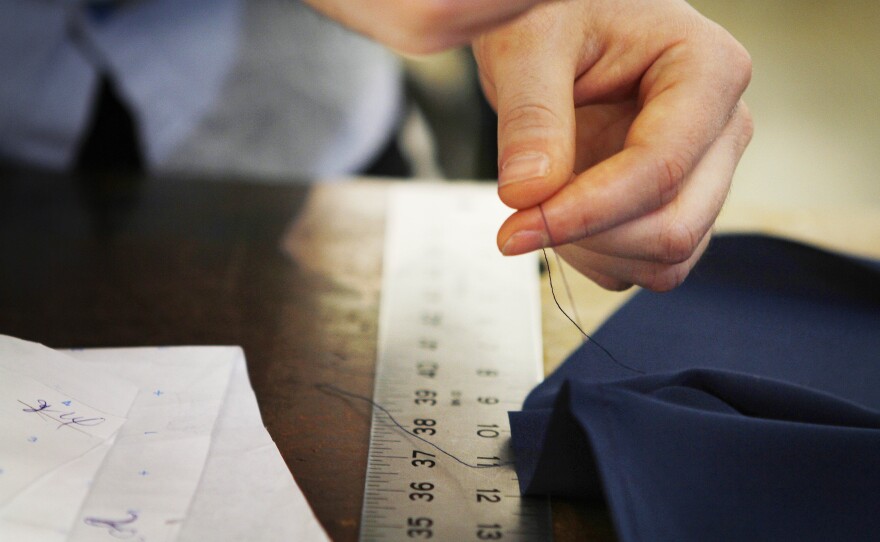









Thursday marks the beginning of New York's Fashion Week, where big name designers like Michael Kors, Anna Sui and Vera Wang will debut their Fall 2013 collections. It's part of an industry that generates billions of dollars of revenue for New York City, employing hundreds of thousands of workers. But the real business of fashion happens several blocks south of the glamorous Lincoln Center runways,in New York's garment district.
For nearly a century, the streets just below Times Square have hatched and sustained many successful American labels. Womens wear designer Ann Yee, who started her own label in 2009, is hoping the same will happen for her.
Style Clash
Just days before her Fall 2013 presentation, Yee is counting zippers -- 50 pearl-colored, invisible, nylon zippers for 50 dresses. She purchases the zippers from Sil Threads on West 38th Street in the heart of the garment district. The price, with a 10 percent discount, which she receives for buying in bulk, is $45. Yee then walks a block over to the factory she's contracted to produce her garments and hands them off to a seamstress.
This is Ann Yee's daily life since deciding to start her own label.
When she doesn't have an intern, which is most days, she's running the errands herself: first to the zipper store, then to the factory, then back out to buy a yard of silk and returning again to the factory. The disparity between the grimy wholesale shops and factories, and the refined finish product is apparent.
"It's not that pretty," Yee says, describing the West Side Manhattan neighborhood. "I'm going to be honest with you. It's not the most visually appealing place in the city. But there's just so many resources that you can't deny it."
Sustaining A New Generation
A recent survey found that 47 percent of New York's designers say they have their samples -- protypes of what you eventually see in stores -- made in the garment district.
According to a 2012 report published by the Design Trust for Public Space, apparel production is the largest manufacturing division in New York City. It provides 24,000 jobs citywide with about 7,100 of those jobs centered in the garment district. Within the garment district alone, those jobs generate $2.1 billion of economic output.
Citywide the fashion industry employs 173,000 people, generating $10 billion annually.
It's also a business that helps young designers realize their dreams. Daniel Vosovic, who started his womens wear collection in 2010, produces all of his garments in New York City.
"I can definitively say that I wouldn't be here if the garment center didn't exist," he says, "because the samples were done by a patternmaker locally; they were cut and sewn by a sample room locally; my showroom is local."
Today, outside Vosovic's studio space, you can hear the sounds of new construction, but not long ago it seemed like the district had outlived its own usefulness. Increasingly, designers were choosing to outsource their production to countries with cheap labor, abandoning midtown manufacturers.
"Maybe for the giants -- maybe Donna Karan doesn't need it. Maybe Ralph Lauren doesn't necessarily need it. But we wouldn't survive. We wouldn't even have gotten the chance to get off the ground if the garment district didn't still exist," Vosovic says.
Vosovic isn't the only one who feels that way. In a survey by the New York Economic Development Corporation, 80 percent of emerging designers insisted they needed the garment district for production.
'Made In NYC'
Meanwhile, Vosovic's business is healthy. Just this season, his Spring 2013 collection was picked up by 23 new stores and he plans to launch his own e-commerce site. But he still doesn't have the minimum orders needed to produce large quantities overseas. His rented studio on West 38th Street is part of an incubator program sponsored by the Council of Fashion Designers of America.
The program, which started in 2010, helps 12 designers get their start by offering them mentorships with industry leaders and discounted rent on studios within the garment district.
Successful designers say it's essential that young designers have control over their production process.
"I made so many mistakes in the beginning. So much waste and so many problems happened," says veteran designer Nanette Lepore, a member of the Council of Fashion Designers of America. "If I had been trying to manage it overseas, I would have surely gone out of business."
Lepore, whose revenues now reach $90 million annually, got her start in the garment district. She says the sewers, patternmakers and suppliers were more than just sources of labor -- they also taught her lessons along the way.
"For me it just makes sense. It's like a no-brainer. It's right here," Lepore explains. "The factories mentored me all through the way through process because it's a hard industry to understand."
She says if U.S. craftsmanship were a dress -- a garment Lepore is particularly known for -- she would describe it as "a strapless dress that won't slide down."
Despite her success, Lepore continues to produce 80 percent of her garments in midtown, with a label that reads "Made in NYC." It's what Yee and Vosovic say they'll do even when they've grown from emerging to established designers.
Copyright 2013 NPR. To see more, visit www.npr.org.






